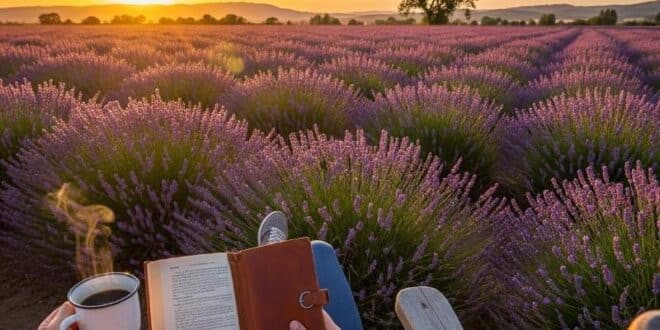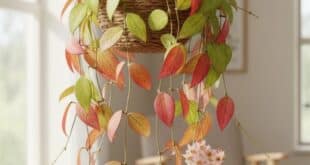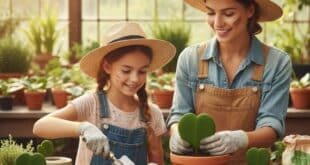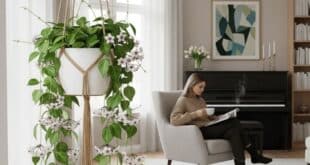The Aromatic Elegance Lavender Plant
Imagine a plant that fills the air with an incredibly soothing fragrance, bursting with beautiful purple blooms that sway gently in the breeze. That’s the magic of the Lavender plant (Lavandula genus)! This iconic beauty is truly a star in gardens and homes, loved for its calming scent, elegant silvery-green leaves, and charming flowers.
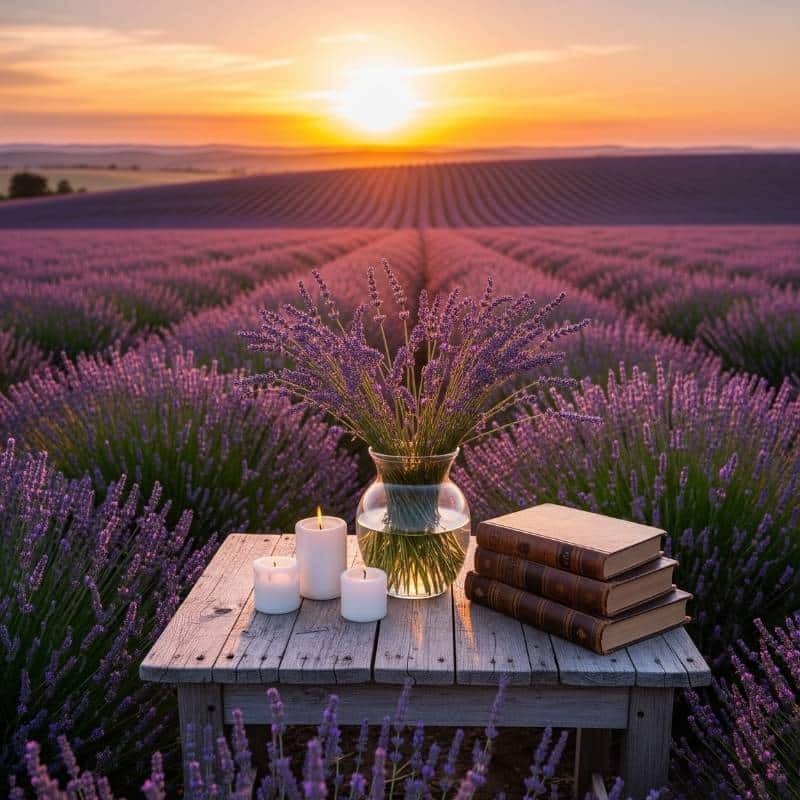
Hailing from the sunny, rocky landscapes of the Mediterranean, Lavender brings a touch of serene charm and sensory delight wherever it grows. It’s fantastic for gardeners who want natural beauty and those who appreciate its calming aroma. While it’s primarily an outdoor plant, with a little extra care, you can sometimes enjoy its peaceful presence indoors too! Are you prepared to uncover the secrets of growing this aromatic marvel? Let’s explore everything you need to know to make your Lavender truly flourish!
What Makes a Lavender Plant So Unique? Its Calming Scent and Purple Spikes
When you look at a Lavender plant, you’ll immediately notice its slender, silvery-green leaves and those signature spikes of tiny, densely packed flowers. Most famously, these flowers are a beautiful shade of purple or blue, but you can also find varieties with pink or white blooms.
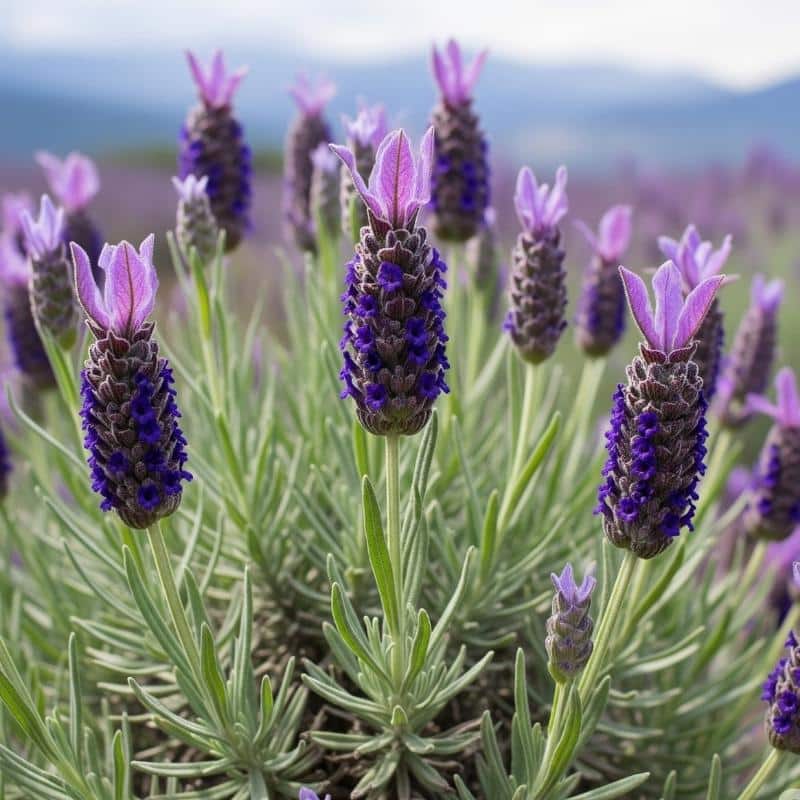
What truly sets Lavender apart is its incredible fragrance! Just brushing against the leaves or flowers releases that familiar, soothing scent that we all know and love. It’s a plant that appeals to both your sight and your smell, creating a wonderfully calming atmosphere.
Where Do Lavender Plants Come From? The Sunny Mediterranean (and Beyond!)
Your Lavender plant’s ancestors come from the sun-drenched, rocky hills and dry slopes of the Mediterranean region (think France, Spain, Italy), and also parts of North Africa, the Middle East, and India. Imagine a place where the sun is abundant, and the soil is quite dry and stony! This background perfectly explains why Lavender absolutely adores full sun and needs super well-draining soil to thrive in our gardens and homes. They’re built for sunny, dry conditions.
What Are Its Other Names? “True Lavender” and Its Ancient Allure
The most common name for Lavandula angustifolia (one of the main types) is “English Lavender” or “True Lavender.” Lavender has been cherished for thousands of years, dating back to ancient Roman and Greek times, where it was used for perfume, bathing, and even medicinal purposes. Its enduring appeal lies in its timeless beauty and that universally loved, calming scent.
What Kinds of Lavender Plants Are There?
While all Lavender plants share that famous fragrance, they come in several popular types, each with its own unique looks and subtle scent variations.
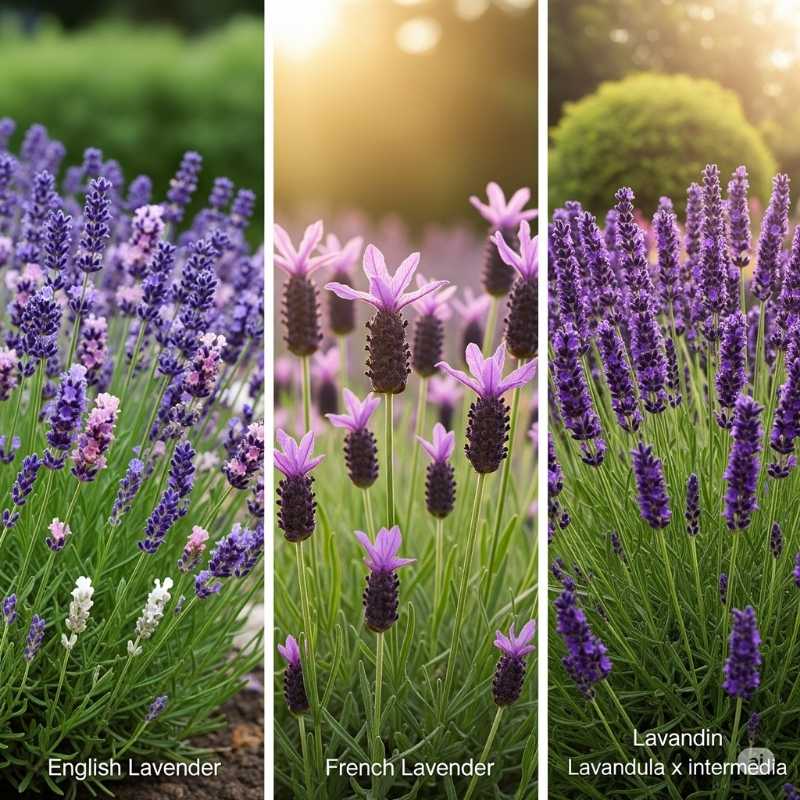
Popular Lavender Types: A World of Fragrance and Form
Here are some common and beloved types of Lavender you might encounter:
| Type of Lavender | Key Features | Flower Look | Hardiness (Outdoor) |
| English Lavender (Lavandula angustifolia) | Most cold-hardy, strongest classic scent (sweet/floral). Popular for culinary use. | Delicate spikes adorned with purple, blue, pink, or white blossoms. | Best for cold climates (Zone 5-9) |
| French Lavender (Lavandula stoechas) | Unique, pineapple-like flower heads with “bunny ear” petals on top. Less cold-hardy. | Compact, barrel-shaped flower clusters accented by unique purple bracts, often referred to as “ears.” | Warmer climates (Zone 8-10) |
| Lavandin (Lavandula x intermedia) | Hybrid, very vigorous, often larger. Strong, camphorous scent. Great for oils/sachets. | Long, dense flower spikes, often a deeper purple. | Zone 5-10, tolerates heat/humidity |
Flower Looks: Spikes, “Ears,” and a Spectrum of Purple
Lavender flowers are usually small, but they make a big impact by growing in dense clusters or spikes. English Lavender has elegant, slender spikes. French Lavender is famous for its unique, almost pineapple-shaped flower heads topped with distinctive “bunny ear” petals (these are actually bracts, modified leaves). The colors range from classic deep purples and blues to softer lavenders, pinks, and even whites.
Foliage Looks: Silvery-Green and Aromatic
The leaves of Lavender plants are typically narrow and have a beautiful silvery-green or grey-green color, giving the plant a soft, airy appearance. They’re wonderfully aromatic even when not in bloom – just gently rub a leaf between your fingers to release that calming scent!
Growth Habit: Bushy, Mounding, and Aromatic
Lavender plants generally grow as compact, bushy, and mounding shrubs. They form dense clumps of foliage topped with their lovely flower spikes. This makes them perfect for creating fragrant borders, low hedges, or beautiful container displays.
How Do You Take Care of Your Lavender Plant?
Caring for Lavender is relatively simple, but they do have specific needs, especially when it comes to sun and drainage. Get these right, and your Lavender will flourish!
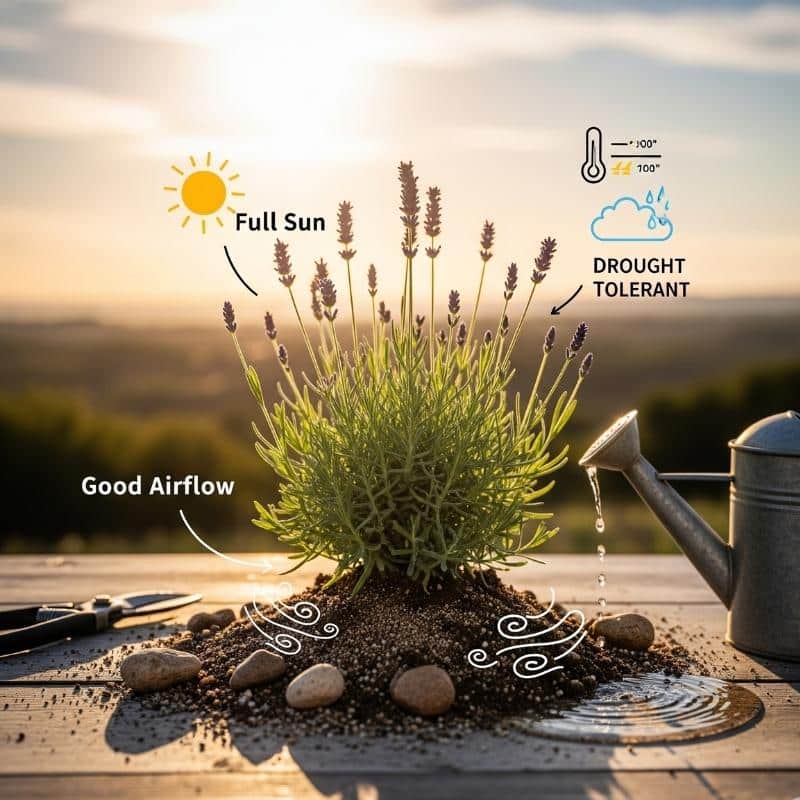
Lavender Care Summary
Here’s a quick overview of what your Lavender loves:
| Care Category | What Your Lavender Needs |
| Light | Full sun! (6-8+ hours of direct sunlight daily). |
| Watering | Drought-tolerant. Water deeply but infrequently (let soil dry out). |
| Soil | Very well-draining, gritty, poor to moderately fertile soil. |
| Temperature | Warm days, cool nights. Hardiness varies by type. Avoid extreme humidity. |
| Airflow | Good air circulation is crucial to prevent fungal issues. |
| Feeding | Rarely needs fertilizer. Prefers poor soil. |
| Pruning | Prune regularly (after flowering & lightly in spring) for shape & more blooms. |
The Right Light: Full Sun is Non-Negotiable!
This is the most crucial tip for happy, fragrant Lavender: it absolutely needs full sun! Aim for at least 6-8 hours of direct sunlight every single day. If your Lavender doesn’t get enough sun, it will become leggy (stretched out), won’t produce many flowers, and its lovely scent will be much weaker. So, pick the sunniest spot you have for it!
Watering Smart: Less is More!
Once established, Lavender is wonderfully drought-tolerant. It truly prefers to be on the drier side. Water thoroughly but sparingly, ensuring the soil dries out completely between each watering. Overwatering is the quickest way to make a Lavender plant unhappy, often leading to yellowing leaves and dreaded root rot. Therefore, when unsure, it’s best to skip watering!
Soil Matters: Sharp Drainage is Key!
This is another non-negotiable for Lavender! It absolutely needs very well-draining, gritty soil that’s poor to moderately fertile. Think rocky, sandy soil like its Mediterranean home. Heavy, wet clay soils are a recipe for disaster and root rot. You can improve drainage by mixing in plenty of sand, grit, or perlite.
Temperature and Airflow: Warm Days, Cool Nights, Good Circulation
Lavender prefers warm, sunny days and cooler nights. Its cold hardiness depends on the type (English Lavender is the toughest in cold). What’s super important, especially if you live in a humid area, is good air circulation. This helps prevent fungal diseases that can crop up in damp, stagnant conditions. Avoid crowding your plants too much.
Feeding Your Lavender: No Rich Food, Please!
Unlike many plants that crave rich soil, Lavender actually prefers poor to lean soil! It rarely needs fertilizer. Giving it too much rich food or fertilizer can lead to weak, leggy growth and fewer flowers, or even cause root problems. If your soil is truly depleted, a very light, balanced organic fertilizer once in spring might be okay, but generally, it’s best to skip it.
Pruning for Bushiness and More Blooms
Pruning is essential for a healthy, bushy Lavender plant that produces lots of flowers!
- After flowering: Deadhead (snip off spent flower spikes) to encourage more blooms. You can also lightly prune the entire plant to maintain its shape.
- Spring: Give it a light trim when new growth appears to encourage bushiness.
- Important: Try to avoid cutting into the old, woody parts of the plant, as it may not regrow from there. Keep it shaped and tidy by pruning the softer, green stems.
What Are Common Problems with Lavender Plants and How to Fix Them?
Lavender is quite resilient outdoors, but it has specific preferences. If it’s unhappy, it’ll let you know!
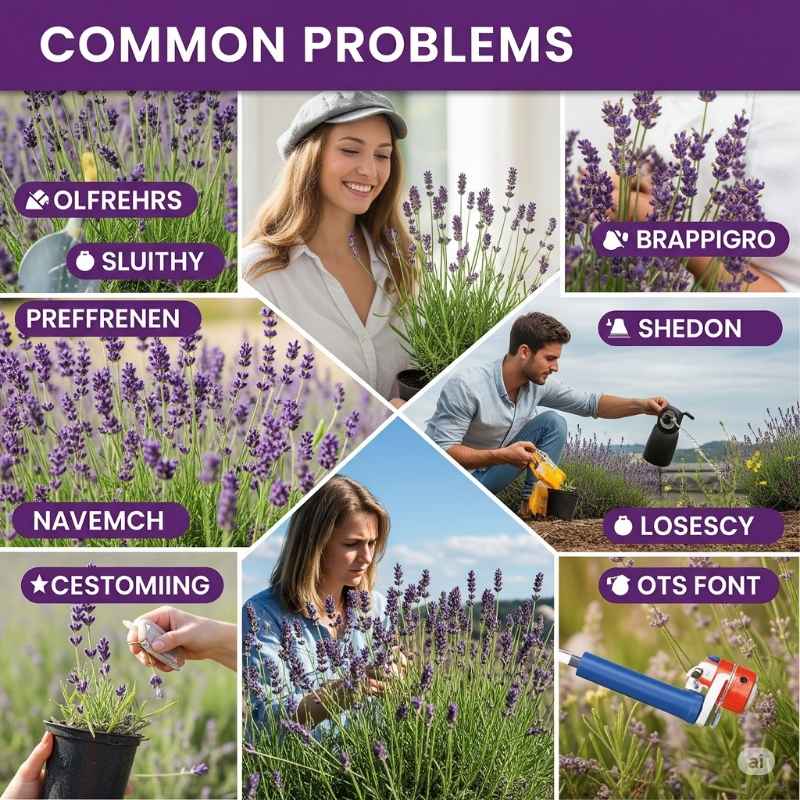
Common Lavender Plant Problems & Solutions
| Problem | What It Looks Like | Common Cause(s) | How to Fix |
| No Blooms (or Weak Scent) | Plant growing but few/no flowers; scent is faint | Not enough direct sun (most common), over-fertilizing, improper pruning, too much water. | Provide 6-8+ hours of direct sun. Don’t over-fertilize. Prune correctly. Ensure excellent drainage. |
| Leggy, Woody Growth | Stretched out stems, sparse leaves, woody base | Not enough light, insufficient pruning | Move to full sun. Prune regularly (after blooming & lightly in spring) to encourage bushiness. |
| Yellowing Leaves/Rotting | Leaves turn yellow, plant looks mushy, wilts | Overwatering, poor soil drainage (most common) | Drastically reduce watering. Improve soil drainage (add grit/sand). Replant if severe. |
| Brown/Crispy Edges/Tips | Leaves turn brown at tips, dry and brittle | Underwatering, very hot/dry conditions (sometimes combined with lack of humidity) | Water deeply when soil is completely dry. Ensure good airflow. |
| Plant Splitting Open | Plant breaks apart in the middle | Over-pruning into old wood, lack of regular shaping, age | Prune lightly from a young age to maintain shape. Avoid harsh cutting into old wood. |
| Pests | Tiny webs, sticky residue, small bugs | General plant stress, poor air circulation | Inspect regularly. Treat with insecticidal soap or neem oil. |
Is the Lavender Plant Toxic? Safety for Pets
Yes, it’s important to know: Lavender plants are considered mildly toxic if ingested, especially in larger quantities. They contain compounds like linalool and linalyl acetate, which can be irritating.
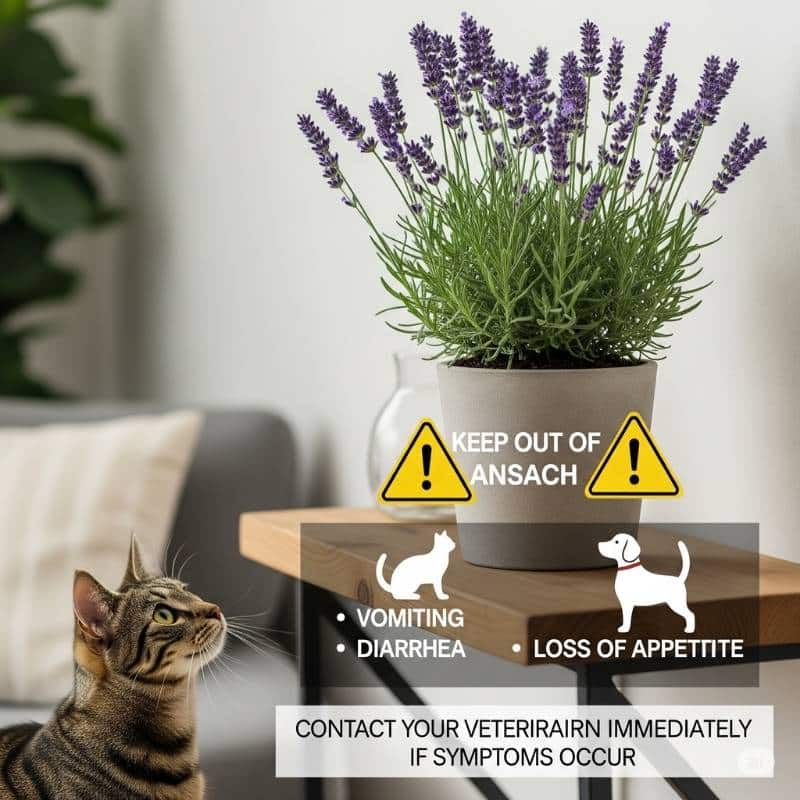
If your cats, dogs, or other pets chew on a Lavender plant, you might see symptoms like:
- Vomiting and diarrhea: This is the most common immediate reaction.
- Loss of appetite.
- Lethargy or weakness.
While typically not life-threatening (unless a very large amount is consumed, which is rare due to the strong taste/smell), it can cause significant discomfort for your pets. It’s also why essential oils, which are highly concentrated, should be used with extreme caution around pets. So, it’s recommended to keep Lavender plants out of reach of curious pets (especially those who like to munch on plants). If you think your pet has eaten any part of a Lavender plant and shows symptoms, please contact your veterinarian immediately for advice.
Lavender Plant for Home & Garden Decor: Sensory Delight and Cottage Charm
The Lavender plant is a decorator’s dream, bringing beautiful visual appeal, delightful fragrance, and a touch of serene charm to any space:
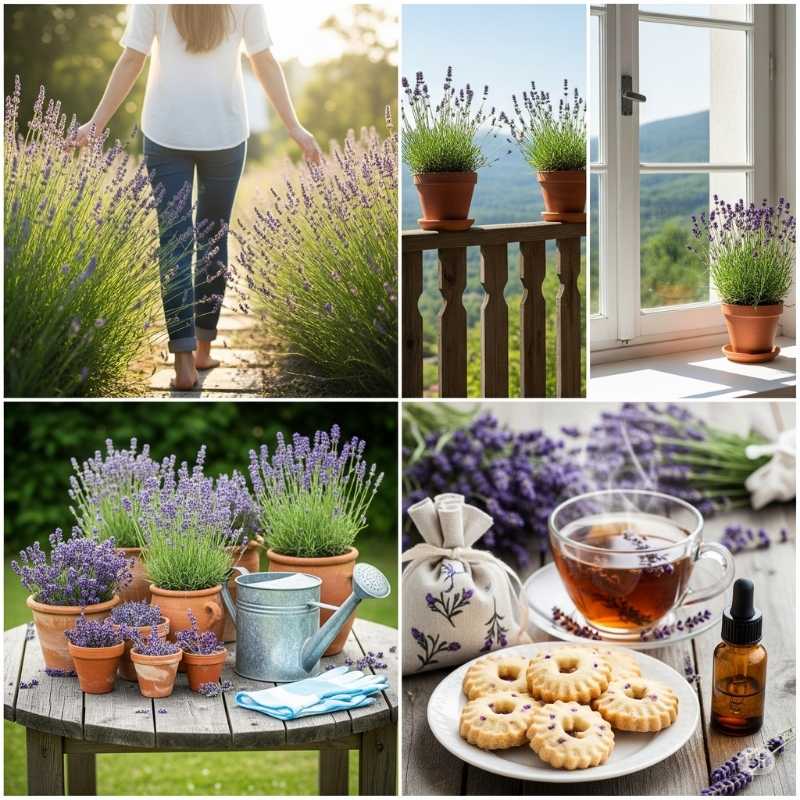
Creating a Fragrant Garden Oasis (Outdoor)
Lavender is absolutely ideal for outdoor spaces! Grow it in borders, beside walkways, within rock gardens, or as a compact hedge. Its uniform growth and incredible scent make it perfect for sensory gardens where you can brush past it and enjoy the aroma.
Perfect for Pots and Containers (Indoor/Outdoor)
Lavender thrives beautifully in pots and containers, both outdoors and indoors (with proper care). This is a fantastic way to enjoy its fragrance on a patio, balcony, or by a sunny window. Just ensure those containers have excellent drainage!
Adding Cottage Charm and Mediterranean Vibes
With its rustic beauty and calming presence, Lavender effortlessly adds cottage garden charm or a Mediterranean feel to your decor. It’s perfect for creating a relaxed, natural aesthetic.
Beyond Beauty: Culinary and Aromatherapy Uses
Lavender isn’t just pretty and fragrant; it’s also incredibly useful!
- Culinary: English Lavender (L. angustifolia) is safe for cooking and baking. Use the flowers in teas, lemonade, shortbread cookies, or even savory dishes.
- Aromatherapy: The dried flowers are perfect for sachets, potpourri, or dried arrangements, filling your home with its calming, natural scent. Lavender essential oil (from certain species) is widely used for relaxation and sleep, though be cautious with pets.
The Allure of Lavender Plants: Aromatic, Resilient, and Rewarding
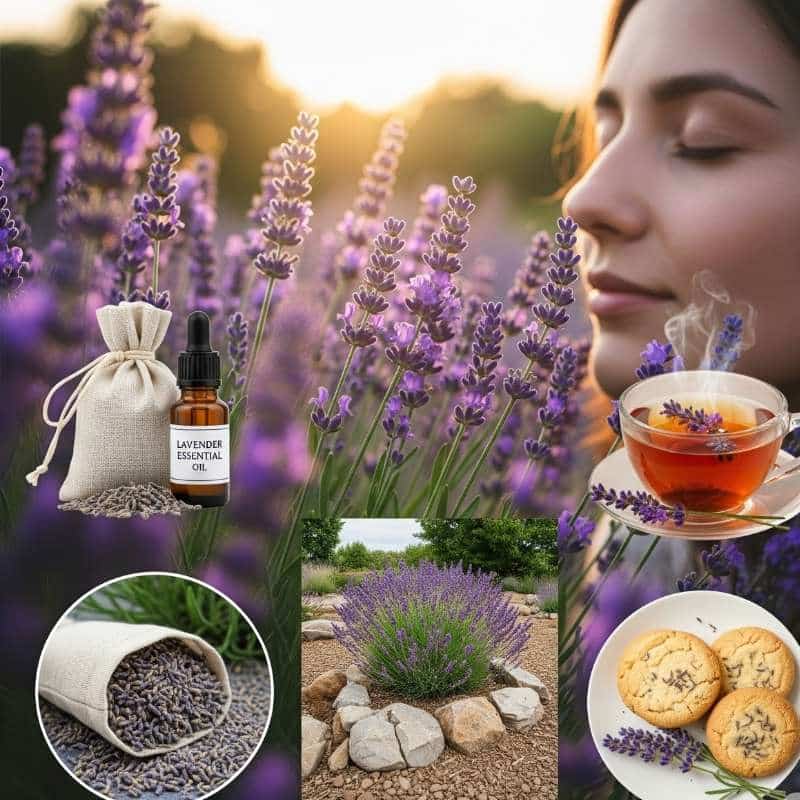
The Lavender plant truly stands out as a top choice for gardeners and home enthusiasts. It offers an unbeatable blend of incredibly soothing fragrance, beautiful blooms, surprising drought tolerance, and versatile uses. While it asks for plenty of sun and precise drainage, the sensory rewards are absolutely worth it. It’s a testament to enduring beauty and natural calm, bringing peace, fragrance, and joy into your home and garden for years to come.
Frequently Asked Questions (FAQ) About Lavender Plants
Still have some questions about your wonderful Lavender? Here are some common ones that might help you out!
Q1: Can I grow Lavender indoors?
A1: Yes, you can grow Lavender indoors, but it’s challenging! It absolutely needs 6-8+ hours of direct sunlight per day, excellent air circulation, and very good drainage. A very sunny, south-facing window is essential, and you might need a grow light in winter. Keep humidity low and ensure consistent airflow to prevent fungal issues.
Q2: How much sun does Lavender need?
A2: Lavender needs full sun! That means at least 6 to 8 hours of direct sunlight every single day to thrive, produce abundant blooms, and have a strong fragrance.
Q3: How often should I water Lavender?
A3: Lavender is drought-tolerant once established. Water deeply but infrequently. Allow the soil to dry out completely between waterings. Overwatering is the most common reason Lavender plants struggle.
Q4: Why isn’t my Lavender blooming?
A4: The most common reasons are not enough sun (needs 6-8+ hours direct light!), over-fertilizing (they prefer lean soil), or improper pruning (don’t cut too hard into old wood, prune after blooming). Ensure it has good drainage and isn’t overwatered.
Q5: How and when should I prune Lavender?
A5: You should prune Lavender after it finishes blooming to remove spent flower spikes and lightly shape the plant. You can also give it a light trim in early spring when new growth appears. The key is to avoid cutting into the old, woody parts of the stem, as it often won’t regrow from there.
Q6: Is Lavender safe for pets?
A6: No, Lavender is considered mildly toxic if ingested by cats, dogs, and other pets. It contains compounds that can cause vomiting, diarrhea, and lethargy. It’s best to keep plants out of reach of curious animals.
Q7: What kind of soil does Lavender like?
A7: Lavender needs very well-draining, gritty, and slightly alkaline soil. It prefers poor to moderately fertile soil. Mix in plenty of sand, perlite, or gravel to ensure excellent drainage. Soils with heavy clay can lead to root rot.
Q8: Can I use fresh Lavender in cooking?
A8: Yes! English Lavender (Lavandula angustifolia) is the best type for culinary use. You can use the fresh or dried flowers sparingly in teas, lemonade, baked goods (like shortbread or cakes), or even savory dishes. A little goes a long way!
Q9: Why are my Lavender leaves turning yellow?
A9: Yellowing leaves on Lavender are almost always a sign of overwatering or poor drainage. Too much moisture in the soil suffocates the roots. Ensure the soil is drying out completely between waterings and that your soil mix drains very well. It can also sometimes be a nutrient deficiency, but poor drainage is usually the first culprit.

